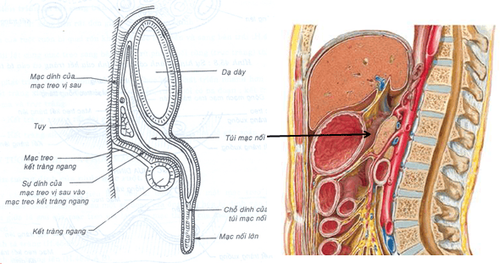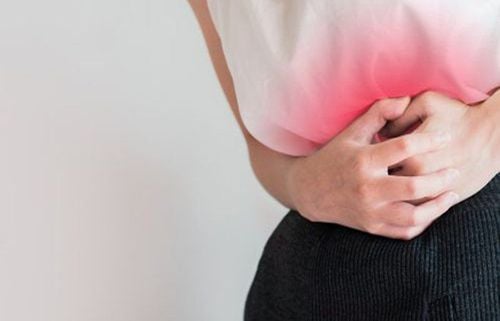This is an automatically translated article.
The article was consulted professionally with Master, Doctor Nguyen Thai Binh - Gastroenterologist - General Surgery Department - Vinmec Ha Long International General Hospital.Primary peritonitis is an infection that begins in the peritoneum, this condition, if not treated in time, can lead to death because the peritoneum is large and rapidly absorbed, so the peritoneal infections easily lead to septic shock to the body. Laparoscopic surgery is one of the most effective treatment methods.
1. What is primary peritonitis?
Anatomical structure of the peritoneum
The peritoneum is the largest serosa in the body, it surrounds the organs of the digestive system, the anterior surface of the pancreas, kidneys, adrenal glands and ureters, the peritoneum forms a shape. shaped like a large and sealed pouch in the abdomen. The structure of the peritoneum includes the parietal peritoneum that covers the inner surface of the abdominal wall, the visceral visceral peritoneum and the intermediate part between the peritoneum of the two organs called the omentum and mesentery. and ligaments. The peritoneal cavity is located between the parietal and visceral leaves, which is a virtual space because the organs are normally pressed together, containing only a little fluid so that the organs can slide past each other easily; The normal peritoneal cavity is a closed space and is open to only 2 fallopian tubes in women. In case of pathology, the fluid in the peritoneal cavity may increase more than usual.

Primary peritonitis is an infection that develops in the peritoneum, the sources of infection are blood, lymphatic or retrograde from the fallopian tube.
Causes and risk factors for primary peritonitis :
Cause: Mainly due to streptococcal bacteria , pneumococcal , tubercle bacilli Risk factors: Primary peritonitis is common in The following subjects are children under 10 years old, elderly people over 60 years old People with immunodeficiency syndromes Having medical diseases such as: cirrhosis of the liver, ascites, nephrotic syndrome, systemic lupus erythematosus, diabetes mellitus, anemia . The case of children after splenectomy. Patients with malnutrition, poor nutritional conditions. Common signs of primary peritonitis:
Abdominal pain: In peritonitis, abdominal pain is a sign that is always present and appears early. Patients often feel pain spreading throughout the abdomen. Severe pain, often continuous pain, increased with movement Digestive disorders: Patients often find nausea, vomiting, loss of appetite; In some cases, signs of semi-obstruction such as defecation and abdominal distension appeared. Signs of infection: Fever, dry lips, dirty tongue, bad breath. Laboratory tests showed an increased white blood cell count and an increased erythrocyte sedimentation rate. Rapid pulse, low blood pressure, fatigue, urinating less. There may be some cases of abdominal ascites. If in the severe stage: The patient may show signs of drowsiness, small rapid pulse, low blood pressure, the worst is coma.
2. Laparoscopic surgery for primary peritonitis
In primary peritonitis, the main method of treatment is medical, using broad-spectrum antibiotics. However, some cases need to be combined with surgical methods for treatment.
Indications for surgery: In some cases, surgery must be indicated, including:
Patients with generalized peritonitis. When the abdominal cavity is full of fluid, surgery is required for the purpose of draining pus and cleaning the abdominal cavity. Suspected secondary peritonitis.

Laparoscopic surgery in the treatment of primary peritonitis is currently quite popular due to its outstanding advantages compared to traditional surgical methods. The advantages of laparoscopic surgery include
Laparoscopic surgery is less invasive, cuts in the abdomen are smaller hence: Smaller internal and external scarring compared to open surgery, less pain. The length of hospital stay is shorter, the hospital stay is shorter, so the cost of treatment is also significantly reduced. Recovery time is faster, patients can quickly be active as healthy people in a short time. As a simple surgical intervention method, there are rarely complications, but in some cases, there may still be risks during surgery such as:
Damage to blood vessels during exploration causing bleeding blood. Perforation of hollow viscera, in this case the puncture will be sutured. Causing damage to the urinary system such as: Cut the ureter, bladder. Postoperative: Postoperative bleeding, intra-abdominal abscess, bowel obstruction. Some notes to follow up after surgery:
Special attention should be paid to the drained fluid in terms of color and quantity. If you see a red drainage, a lot of abnormalities, you should immediately notify the medical staff. Regularly monitor vital signs. Patients are used antibiotics according to the results of resistance, rehydration, electrolytes, blood if necessary. Most cases of primary peritonitis have a good prognosis, often responding well to treatment. However, some cases of late detection are at risk of death from sepsis, especially in subjects with weak resistance. So when you see signs of suspicion, you should go to the doctor and get treatment early to solve the cause of the infection. Vinmec International General Hospital has good experts and the most modern equipment. Please contact us for the most timely advice, examination and treatment to avoid affecting your health.
Please dial HOTLINE for more information or register for an appointment HERE. Download MyVinmec app to make appointments faster and to manage your bookings easily.














